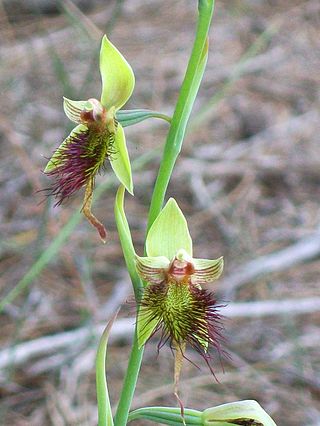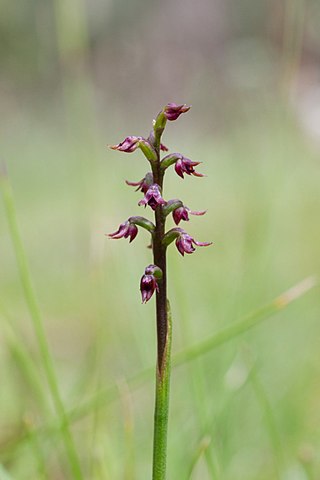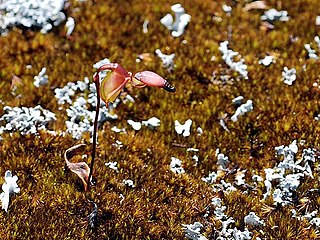
Caleana, commonly known as duck orchids, is a genus of flowering plants in the orchid family, Orchidaceae that is found in Australia and New Zealand. The Australian species are found in all states but have not been recorded in the Northern Territory. Duck orchids have a single leaf and one or a few, dull-coloured, inconspicuous flowers. Most species are found in Western Australia but one species occurs in eastern Australia and one occurs in eastern Australia and New Zealand. Orchids in this genus as well as the hammer orchids (Drakaea) are pollinated by male thynnid wasps.

Calochilus paludosus, commonly known as the red beard orchid or red beardie, is a species of orchid native to Australia and New Zealand. It has a single fleshy, light green leaf and up to nine greenish flowers with reddish stripes. The labellum has a dull red or coppery coloured beard and lacks the "eye" spots of other beard orchids.

Caleana major, commonly known as the large duck orchid, is a small orchid found in eastern and southern Australia. This terrestrial plant features a remarkable flower, resembling a duck in flight. The flower is an attractant to insects, such as male sawflies which pollinate the flower in a process known as pseudocopulation. In 1986 this orchid was featured on an Australian postage stamp.

Caleana nigrita, commonly known as the small duck orchid or flying duck orchid is a species of orchid endemic to the south-west of Western Australia. It is the most common of the flying duck orchids and has the widest distribution of the Western Australian species. It has a single smooth leaf and is distinguished from the others by its labellum which has a hump in the middle and calli covering two thirds of its outer end. Its dull colouration makes it difficult to find, especially in areas that are blackened by fire.

Prasophyllum caudiculum, commonly known as the Guyra leek orchid, is a species of orchid endemic to a small area of northern New South Wales. It has a single tubular, bright green leaf and up to thirty five greenish to reddish-brown flowers crowded along an erect flowering stem. It grows in grassy places near Guyra.

Genoplesium nudum, commonly known as the tiny midge orchid in Australia or the red midge orchid in New Zealand, is a small terrestrial orchid native to south-eastern Australia and New Zealand. It has a single thin leaf fused to the flowering stem and up to forty small, reddish-purple or green and red flowers. Australian and New Zealand authorities use the name Corunastylis nuda but Genoplesium nudum and Prasophyllum transversum are used by the World Checklist of Selected Plant Families.
Genoplesium pedersonii, commonly known as Pederson's midge orchid, is a species of small terrestrial orchid endemic to the Blackdown Tableland in Queensland. It has a single thin leaf fused to the flowering stem and up to thirty small, greenish red to reddish, self-pollinating flowers with a dark purplish red labellum. The species is treated as Corunastylis pedersonii in Queensland.
Genoplesium simulans, commonly known as the Blue Mountains midge orchid is a small terrestrial orchid which is endemic to New South Wales, where it mainly occurs in the Blue Mountains. It has a single thin leaf and up to twenty three dark purplish-black flowers which lean downwards.
Corunastylis densa, commonly known as the dense midge orchid, is a small terrestrial orchid endemic to eastern Australia. It has a single thin leaf fused to the flowering stem and up to twenty five densely crowded reddish-brown to dark purplish-brown flowers. It is found between the New England National Park and the Moroka River.
Caleana alcockii, commonly known as Alcock's duck orchid is a rare species of orchid endemic to the south-west of Western Australia. It has a single smooth leaf and is distinguished by its humped labellum and relatively late flowering period. It only occurs north of Geraldton.

Caleana brockmanii, commonly known as Brockman's duck orchid is a species of orchid endemic to the south-west of Western Australia. It has a single smooth leaf, a single greenish yellow and red flower and is distinguished by its flat labellum, relatively late flowering period and calli only near the tip of the labellum. It is found south from Perth.
Caleana disjuncta, commonly known as the little duck orchid, is a species of orchid that is found in Western Australia but with a few disjunct populations in Victoria and South Australia. It has a single smooth leaf and a single greenish yellow and red flower with a flattened labellum, the calli only near its tip.

Caleana dixonii, commonly known as the sandplain duck orchid is a rare species of orchid endemic to the south-west of Western Australia. It has a single smooth leaf and a single greenish yellow and fawn-coloured flower. It is distinguished by its flattened labellum with calli only near the tip of the labellum and its preference for growing on sandplains.

Caleana granitica, commonly known as the granite duck orchid is a species of orchid that is endemic to the south-west of Western Australia. It is a species of duck orchid with a single smooth leaf and a single greenish yellow and red flower with the labellum held below the horizontal. It grows on a single granite outcrop near Armadale.

Caleana hortiorum, commonly known as Hort's duck orchid is a species of orchid endemic to the south-west of Western Australia. It has a single smooth leaf, a single greenish yellow and red flower and is distinguished by its long, narrow, slightly humped labellum, with calli on its outer half. It is found between Perth and Albany.

Chiloglottis anaticeps, commonly known as the duck's-head wasp orchid or bird orchid is a species of orchid endemic to the New England Tableland of New South Wales. It has two narrow leaves and a single greenish brown or reddish flower with a shiny, dark green callus occupying most of the top of the labellum. One end of the callus looks like a tiny duck's head.
Caleana lyonsii, commonly known as the midget duck orchid is a species of orchid endemic to the south-west of Western Australia. It is distinguished by its single smooth narrow leaf which is usually withered by flowering time and its up to ten small, greenish flowers. It grows in harsh environments in disjunct populations between Kalbarri and Southern Cross and has the smallest flowers of its genus in Western Australia.
Caleana parvula, commonly known as the Esperance duck orchid is a species of orchid endemic to a small area near Esperance in the south-west of Western Australia. It has a single smooth leaf and usually only a single greenish yellow and red flower. It is distinguished by its small flower with the calli only on the outer one-fifth of the labellum. The only other Caleana species in Western Australia which is smaller is C. lyonsii.
Caleana terminalis, commonly known as smooth-billed duck orchid is a species of orchid endemic to a small area near the Murchison River in the south-west of Western Australia. It has a single smooth leaf and usually only a single greenish yellow and red flower. It is distinguished by its slightly humped labellum, with calli only on its outer one fifth.
Arthrochilus oreophilus, commonly known as montane elbow orchid, is a flowering plant in the orchid family (Orchidaceae) and is endemic to higher places in far north Queensland. It has a rosette of leaves at its base and up to fifteen green, insect-like flowers with dark reddish brown glands on its labellum.











